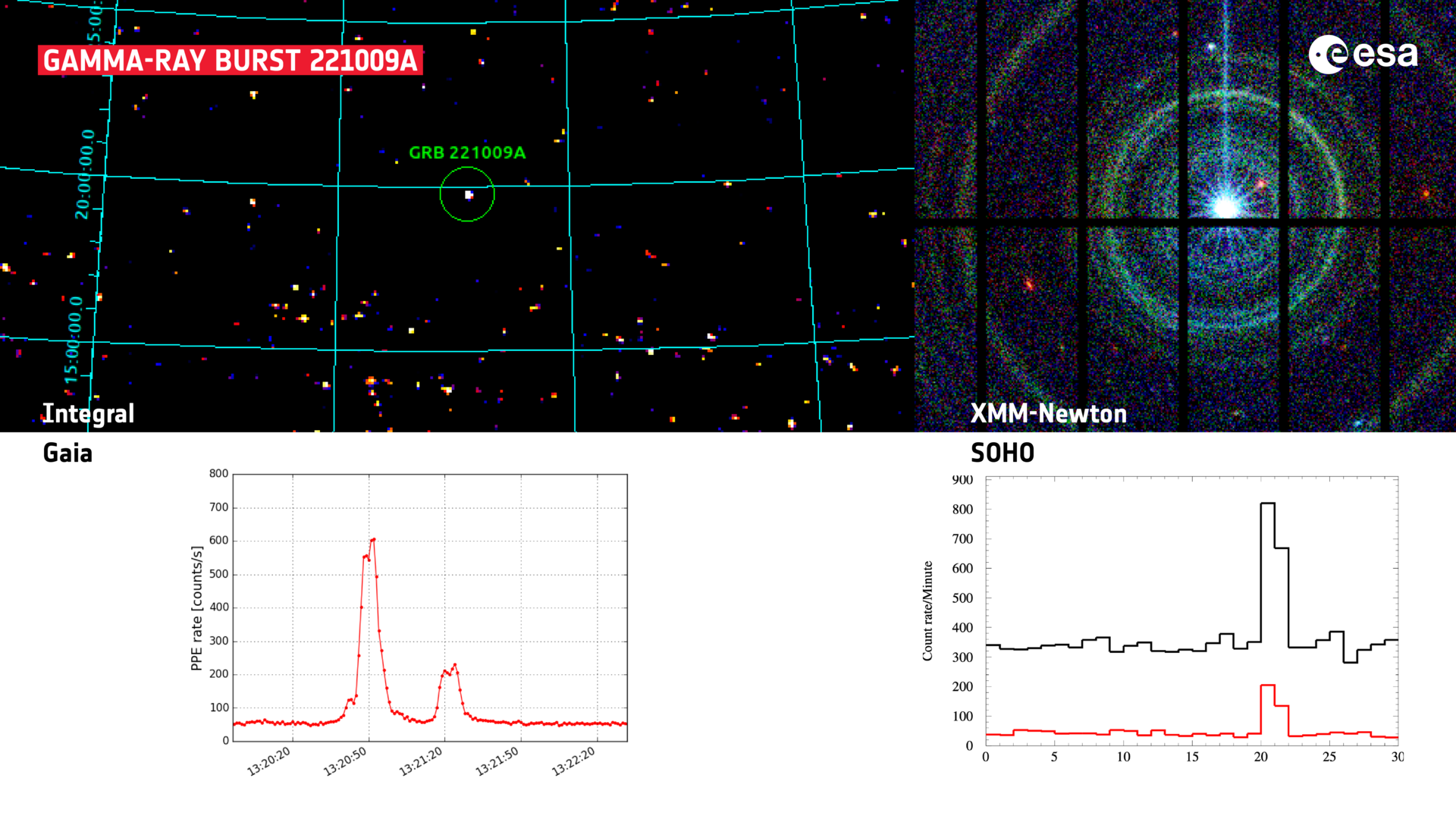
An explosive gamma-ray burst, one of the brightest ever detected, lit up in the sky on 9 October 2022.
A gamma-ray burst is a super energetic explosion and this one originated in the constellation Sagitta. The signal of the burst – called GRB 221009A – was picked up by many ESA observatories. Some suddenly noticed an increase in their detection of high-energy emission, others were pointed towards the source soon thereafter. The event took place some 1.9 billion years ago and likely indicates the birth of a black hole.
The energetic particle detector EPHIN on the SOHO spacecraft and the non-star object counter in the Sky Mapper instrument on the Gaia spacecraft picked up a signal at the same time around 13:20 UTC (15:20 CEST) on 9 October 2022. Gaia engineers were puzzled at first by this abnormal signal but soon discovered they had measured GRB 221009A. Graphs of the event by Gaia and SOHO are shown on the bottom of the image. The vertical shows the count of high-energetic particles/non-star objects over time. A clear peak shows the sudden detection of a high count.
The upper left image was taken by the IBIS/ISGRI instrument onboard the Integral spacecraft. It shows the bursts’ location in the sky as a source of powerful gamma rays. This long-exposure image was taken a day after the explosion and shows the still active site. Various other instruments on Integral noticed the initial burst as well, for example the SPI/ACS instrument measured gamma rays from the burst itself.
After the discovery, XMM-Newton was pointed towards the location on the sky. The result is a magnificent picture (top right) of the echo of the burst showing X-rays scattering off interstellar dust in our galaxy in marvelous rings. Click here to access the separate XMM-Newton image.
The ESA-led Solar Orbiter and BepiColombo missions also noticed the burst. Solar Orbiter detected X-rays of the burst with its STIX instrument. Its EPD instrument detected energetic particles that were created after interaction of the high-energetic emission with the spacecraft itself. BepiColombo measured gamma rays; the data are being analysed.
The burst provided an unexpected occasion where different ESA missions came together to study the same astronomical event.
ESA designs and operates a world-class science programme together with its Member States, with a long-term vision of leadership in many fields of space science. ESA Science is a global leader especially in the physics of the hot and energetic Universe, like black holes and their environment. It is not the first time that several of ESA’s missions observed the same event independently, but it is unusual that an event in the distant Universe is detected across the fleet, including missions designed to explore the Solar System rather than the deep Universe.
https://news.google.com/__i/rss/rd/articles/CBMiaWh0dHBzOi8vd3d3LmVzYS5pbnQvRVNBX011bHRpbWVkaWEvSW1hZ2VzLzIwMjIvMTAvRVNBX3NwYWNlY3JhZnRfY2F0Y2hfdGhlX2JyaWdodGVzdF9ldmVyX2dhbW1hLXJheV9idXJzdNIBAA?oc=5
2022-10-21 07:32:15Z
1606166319
Tidak ada komentar:
Posting Komentar